DAVAO CITY (MindaNews / 25 June) – Sunday, October 7, 2012 was a historic day for the Moro people as it marked the first time the Bangsamoro was finally, officially recognized by the Philippine government. President Benigno Simeon Aquino III announced that the peace panels of the government and the Moro Islamic Liberation Front (MILF) had reached a framework agreement that would give birth to a new autonomous political entity whose name “symbolizes and honors the struggles of our forebears in Mindanao” and “celebrates the history and character of that part of our nation.”
“That name will be Bangsamoro,” Aquino said in a 10-minute speech aired live nationwide and streamed live from Malacanang into the State Room of the Palace of the Golden Horses hotel in Kuala Lumpur where members of the peace panels watched, broke into cheers (some in tears), applauded ten times and gave him (and themselves), a standing ovation as he ended his speech, thus: “Finally, we have achieved peace, a peace that will serve as the foundation of our dreams for Bangsamoro, for Mindanao, and for the entire Filipino nation.”
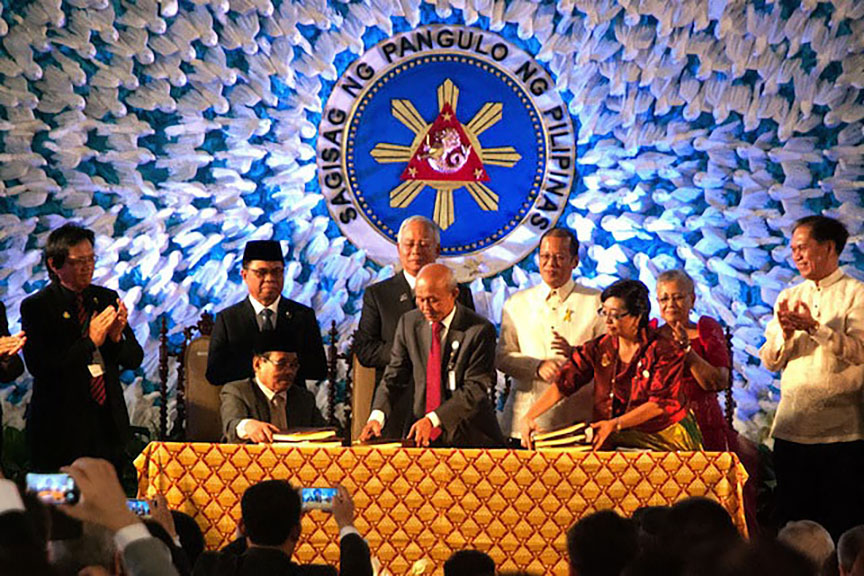 The Philippine government under President Benigno Simeon Aquino III and the Moro Islamic Liberation Front finally sign the Comprehensive Agreement on the Bangsamoro in Malacañang on 27 March 2014 after 17 years of negotiations. MindaNews photo by Julius Mariveles / Philippine Center for Investigative Journalism
The Philippine government under President Benigno Simeon Aquino III and the Moro Islamic Liberation Front finally sign the Comprehensive Agreement on the Bangsamoro in Malacañang on 27 March 2014 after 17 years of negotiations. MindaNews photo by Julius Mariveles / Philippine Center for Investigative Journalism
The news of Aquino’s demise on Thursday morning, June 24, was “unfortunate,” according to Mohagher Iqbal, chair of the MILF peace panel that negotiated with the government and signed the Framework Agreement on the Bangsamoro (FAB) on October 12, 2012 and the Comprehensive Agreement on the Bangsamoro (CAB) on March 27, 2014, “especially when we recall his commitment to the Bangsamoro people and the peace process. Indeed, he was the first Filipino leader, nay president, who used and accepted the nomenclature Bangsamoro.”
For the MILF and the Bangsamoro people, Iqbal said, Aquino will be regarded as a “stalwart supporter and partner for peace, justice, and prosperity in Mindanao,” recalling how his “steadfast leadership created an environment that allowed the GPH-MILF peace process to achieve significant milestones” such as the 10 Decision Points, FAB and its four annexes, the Addendum on Bangsamoro Waters and Zones of Joint Cooperation, the CAB and “the beginnings” of the Bangsamoro Basic Law (BBL).
“He was an inspiring individual who used his voice and aptitude to place critical issues of the Bangsamoro at the forefront. While we are saddened to have lost a great friend of the Bangsamoro, we do not doubt that his legacy will live on,” said Iqbal, now Minister of Education of the Bangsamoro Autonomous Region in Muslim Mindanao (BARMM) and chair of the MILF’s peace implementing panel.
At the signing of the FAB in Malacanang on October 15, 2012, MILF chair Al Haj Murad Ebrahim said the FAB was the “most important document in the chapter of our history, a landmark document that restores to our people their Bangsamoro identity and their homeland, their right to govern themselves and the power to forge their destiny and their future with their very own hands.”
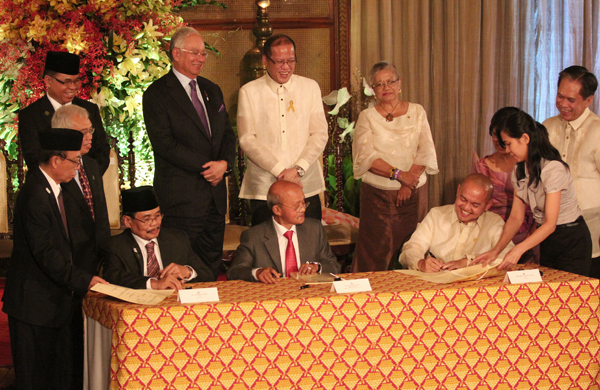 SIGNED. The government and the Moro Islamic Liberation Front (MILF) signed the Bangsamoro Framework Agreement at the Malacanang Palace on Monday, October 15, 2012. GPH peace panel chair Marvic Leoenen and MILF peace panel chair Mohagher Iqbal signed the agreement. (L-R) MILF Secretariat head Jun Mantawil, peace panel memberAtt. Michael Mastura, MILF chair Al Hadj Murad Ibrahim, Malaysian Prime Minister Dato’ Sri Mohd Najib bin Tun Abdul Razak, President Benigno Aquino III, OPAPP chair Teresita Deles, GPH peace panel members Miriam Coronel Ferrer and Senen Bacani. Mindanews photo by KEITH BACONGCO
SIGNED. The government and the Moro Islamic Liberation Front (MILF) signed the Bangsamoro Framework Agreement at the Malacanang Palace on Monday, October 15, 2012. GPH peace panel chair Marvic Leoenen and MILF peace panel chair Mohagher Iqbal signed the agreement. (L-R) MILF Secretariat head Jun Mantawil, peace panel memberAtt. Michael Mastura, MILF chair Al Hadj Murad Ibrahim, Malaysian Prime Minister Dato’ Sri Mohd Najib bin Tun Abdul Razak, President Benigno Aquino III, OPAPP chair Teresita Deles, GPH peace panel members Miriam Coronel Ferrer and Senen Bacani. Mindanews photo by KEITH BACONGCO
“Today we are here to put an end to the adversarial relationship between the Bangsamoro and the Philippine nation. Today we extend our hands of friendship and partnership to the President and the Filipino people as we jointly embark on the historic journey to rebuild our homeland, institute justice, end occupation and the reign of violence and restore normalcy to the masses of our people in Mindanao and Sulu,” he said.
Aquino asked the entire nation and the entire world to join him in “imagining a Mindanao finally free from strife, where people achieve their fullest potential.”
First two weeks of Presidency
When he assumed the Presidency on June 30, 2010, among the first issues he immediately attended to was the Bangsamoro peace process.
The peace processes between government and the MILF and with the Moro National Liberation Front (MNLF) were in limbo as the nine-year Arroyo administration came to a close, following the botched signing of the already initialed Memorandum of Agreement on Ancestral Domain (MOA-AD) with the MILF in 2008 and the armed clashes that followed, and the unimplemented provisions of the 1996 Final Peace Agreement with the MNLF.
By July 15, 2010, Aquino had named Marvic Leonen, then Dean of the University of the Philippines’ College of Law, as chair of the government peace panel that would negotiate with the MILF.
Aquino had envisioned that within his six-year term, a peace agreement would be signed with the MILF and the tripartite review of the implementation of the FPA with the MNLF, which was started under the Arroyo administration, would be completed.
His mother, Corazon, who became President after People Power ousted the Marcos dictatorship in February 1996, had attempted to negotiate peace with the MNLF and MILF. Against the advice of her security sector, she went to Jolo, Sulu on September 5, 1986 to meet with MNLF chair Nur Misuari to ask him to return to the negotiating table. No peace agreement was signed under her administration. It would be signed under her successor, President Fidel V. Ramos. The Ramos administration also formally opened peace negotiations with the MILF in 1997.
When the GPH and MILF peace panels were facing difficulties in getting off the ground, President Aquino proposed in June 2011 to meet with Murad so they could discuss how to fast-track the peace process. By then, one year was over and he only had five years left of his term. Aquino, according to MindaNews sources, was even willing to meet with Murad in the latter’s Camp Darapanan, a proposal turned down by his security sector.
Accompanied by some Cabinet members, Aquino flew to Narita, Japan on August 4, 2011 to meet with Murad and the MILF Central Committee.
There, Aquino asked Murad if they could work on a peace agreement within the first half of the Aquino administration (until June 30, 2013) so that the last half (2013 to 2016) would be the implementation of the peace agreement.
It was a meeting kept under wraps. In fact, President Aquino was curiously silent about the peace process in his 2nd State of the Nation Address on July 25, 2011. It turned out to be deliberate as the MILF peace panel had agreed in June to accept the offer of Aquino to personally meet with Murad and the Central Committee. Iqbal said the government offered a “grand gesture” but gave no details.
Malaysia had been the facilitator and host of the talks since 2001. The venue chosen for the Aquino-Murad meeting was Japan, the nearest member-country among the International Monitoring Team and International Contact Group which were part of the GPH-MILF peace process mechanisms.
MindaNews broke the story on the historic meeting after getting confirmation and details from both Leonen and Iqbal early morning of August 5, 2011, shortly before the President’s delegation flew back to Manila. August 5 was exactly three years to the day the MOA-AD was supposed to have been signed in Kuala Lumpur.
Game changers
That two-hour meeting in Narita, Japan between Aquino and Murad, with their respective panel chairs taking down notes, was a game changer.
“Absolutely,” Teresita Quintos-Deles, then Presidential Adviser on the Peace Process, told MindaNews on Thurdsay.
For Murad, now BARMM Chief Minister and now referred to by his real name, Ahod Balawag Ebrahim, “the sincerity of his (Aquino’s) administration was highlighted when we personally met in Narita, Japan.”
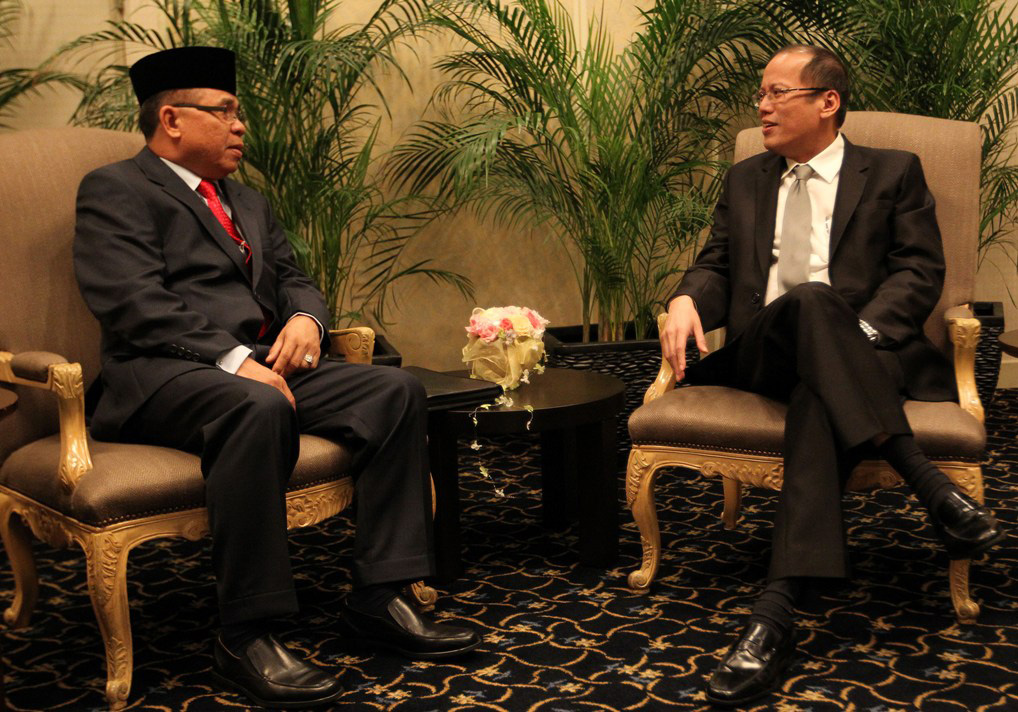 President Benigno Aquino III and Moro Islamic Liberation Front Chair Al Haj Murad Ebrahim discuss peace in a hotel in Japan on August 4, 2011, to fast-track the peace process. MindaNews photo courtesy of the Office of the Presidential Adviser on Peace Process.
President Benigno Aquino III and Moro Islamic Liberation Front Chair Al Haj Murad Ebrahim discuss peace in a hotel in Japan on August 4, 2011, to fast-track the peace process. MindaNews photo courtesy of the Office of the Presidential Adviser on Peace Process.
“Because of the confidence by both parties in the peace process during his term, we saw the eventual signing of the Framework Agreement on the Bangsamoro and the Comprehensive Agreement on the Bangsamoro — documents that would pave way to the foundations of the Bangsamoro Autonomous Region in Muslim Mindanao,” Murad said in a statement Thursday. The Bangsamoro people, he said, “are forever grateful for his administration’s efforts in revitalizing the peace talks and their help in laying the groundwork for lasting peace in Mindanao.”
Because the Aquino administration focused on the peace processes, the Bangsamoro had a respite from war from 2010 to 2016, after a succession of wars from the Estrada administration (1998 to 2001) and the Arroyo administration 2001 to 2010). Hundreds of thousands of Moro residents were displaced during the all-out war in 2000 waged by President Joseph Estrada and in 2003 by President Gloria Macpagal-Arroyo, both, ironically, while in the midst of peace negotiations. In 2008, armed clashes occurred following the aborted signing of the MOA-AD.
When he stepped down as President on June 30, 2016, the Aquino administration had signed the FAB and CAB and completed the tripartite review of the peace agreement with the MNLF.
Shortly after the signing of the FAB, Aquino immediately issued an executive order creating the Bangsamoro Transition Commission (BTC) to draft the BBL. Aquino named the 15-member body — eight nominated by the MILF and seven by the government — on February 25, 2013.
Congress was deliberating on the BBL when the Mamasapano Tragedy happened on January 25, 2015 in Maguindanao, leaving 66 persons dead: 44 from the Special Action Forces (SAF) of the Philippine National Police, 17 members of the MILF’s Bangsamoro Islamic Armed Forces and five civilians.
Sixty-six Filipinos, not only 44, were killed when the SAF launched ‘Oplan Exodus,’ a dawn operation to arrest a high-value target without coordinating with the military and ceasefire mechanisms of the peace process.
Mamasapano, turned out to be another game changer in the GPH-MILF peace process. The Mamasapano tragedy led to yet another tragedy: the death of the BBL.
“Biggest casualty is the future”
“We were on the way to the approval of the BBL. The committee hearings were going smooth until the Mamasapano incident took place,” then Senate President Franklin Drilon said.
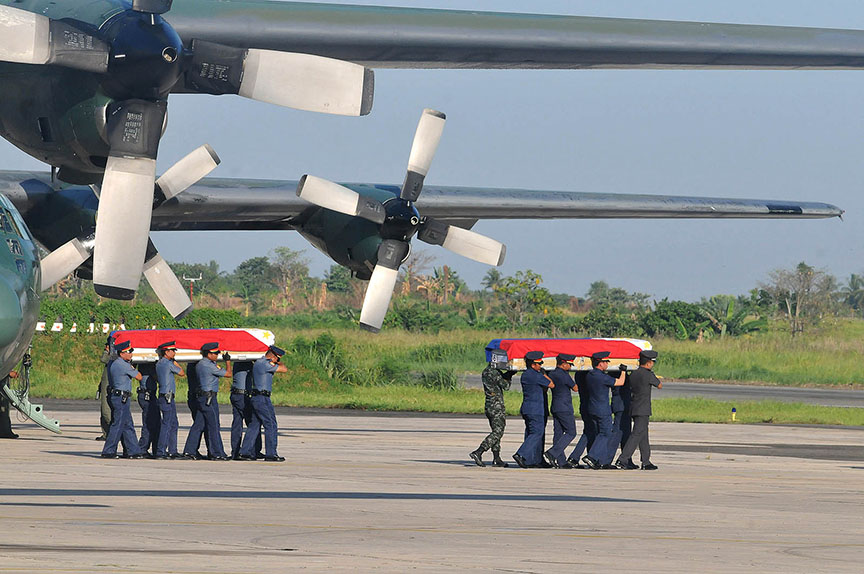 Fellow police officers carry the caskets of slain policemen involved in the 25 January 2015 Mamasapano clash to be flown by Philippine Air Force C-130 planes to Manila. Forty-four Special Action Force troopers, 17 members of the Moro Islamic Liberation Front and 5 civilians were killed in the SAF’s dawn operation to arrest Malaysian terrorist Zulkifli bin hir aka Marwan. MindaNews photo by FROILAN GALLARDO
Fellow police officers carry the caskets of slain policemen involved in the 25 January 2015 Mamasapano clash to be flown by Philippine Air Force C-130 planes to Manila. Forty-four Special Action Force troopers, 17 members of the Moro Islamic Liberation Front and 5 civilians were killed in the SAF’s dawn operation to arrest Malaysian terrorist Zulkifli bin hir aka Marwan. MindaNews photo by FROILAN GALLARDO
Before the tragedy, both houses were eyeing to pass the law by February or March 2015 to give sufficient time for the ratification and what was supposed to be a shortened transition period before the election of the first set of officials of the Bangsamoro government on May 9, 2016.
According to the GPH-MILF peace roadmap, the Bangsamoro region would have been inaugurated on June 30, 2016, the same day Aquino would step down from his six-year stay in office.
“In fairness to the legislature, we did our best but you can operate only in a political environment conducive to the passage of this bill. Unfortunately, after the Mamasapano incident, the environment became very toxic. I can say that I think the BBL is the 45th victim in Mamasapano,” Drilon said.
Within the week of the tragedy, Cardinal Orlando Quevedo, then the Archbishop of Cotabato, warned that the biggest casualty in the Mamasapano tragedy was not only the lives lost but “the future.”
“The future is represented by the Bangsamoro Basic Law. If it falls by the wayside, the future is unthinkable. Where else can we go without its promise of a just and lasting peace? Where else do we go after many, many years of discussion?”
In his keynote address before a gathering of Mindanao and Manila media in Cotabato City in July 2015, Quevedo narrated that in the legislative hearings to investigate the Mamasapano tragedy, “several of our legislators expressed the biases, prejudices, and mistrust of the Christian majority against Moros in general and against the BBL in particular.”
“These biases were sown during the period of colonization when relationships between Moros and Christians were characterized by continuing conflict, negative experiences with Moros, the diversity of religious beliefs and culture. Dormant through many decades and occasionally rearing its head as in the Ilaga-Barracuda armed conflicts during Martial Law, bias and prejudice suddenly erupted into the open in the wake of the Mamasapano tragedy,” he added.
“Heart for the Bangsamoro”
Despite the setbacks, the Aquino administration and the MILF forged ahead to implement provisions in the FAB and CAB that required no legislation.
On June 16, 2015. Aquino went to Sultan Kudarat town in Maguindanao to witness the ceremonial turnover of 55 high-powered and 20 crew-served weapons of the MILF’s BIAF to the Independent Decommissioning Body and the decommissioning of 145 combatants.
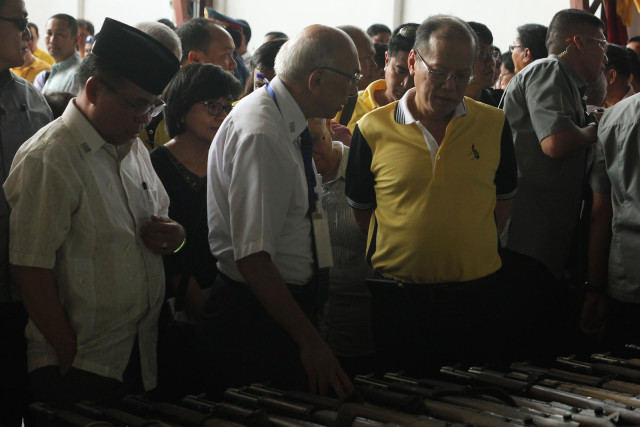 Moro Islamic Liberation Front chair Al Haj Murad Ebrahim and President Benigno Aquino III inspect the firearms during a ceremonial turnover at the old Maguindanao provincial capitol in Sultan Kudarat on June 16, 2015. The MILF turned over a total of 75 weapons as an initial step toward decommissioning. MindaNews photo by TOTO LOZANO
Moro Islamic Liberation Front chair Al Haj Murad Ebrahim and President Benigno Aquino III inspect the firearms during a ceremonial turnover at the old Maguindanao provincial capitol in Sultan Kudarat on June 16, 2015. The MILF turned over a total of 75 weapons as an initial step toward decommissioning. MindaNews photo by TOTO LOZANO
Mamasapano would hound Aquino in the last 17 months of his administration and even after stepping down as President. As Citizen Noy, he was summoned for investigation, faced charges, but was cleared of the charges related to Mamasapano in September 2019.
Drieza Lininding, chair of the Marawi City-based Moro Consensus Group who openly criticized Aquino for his administration’s failure to pass the BBL and for Mamasapano, said Aquino, compared with other Presidents, was the only one who did not wage war against the Moro, or “pinapatay ang mga Moro (di tulad ngayon) “are killing the Moro (unlike now).” He said Aquino spent time and resources waging peace instead of war.
No BBL was passed under the Aquino administration. Republic Act 11054 or the Organic Law for the BARMM, popularly referred to as the Bangsamoro Organic Law (BOL), was passed by Congress under the Duterte administration in 2018 and the BRMM was established in early 2019.
“Walang BOL ngayon kung walang Comprehensive Agreement on Bangsamoro na pinagusapan ng ilan taon” (There would be have been no BOL if there had been no CAB that was negotiated for years),” Lininding said.
He noted that it was under the Aquino administration when the struggle of the Bangsamoro struggle was duly recognized, that Aquino did not allow himself to be swayed by “hawkish people” in government. In Filipino, he said, “we were freer to express ourselves without fear or apprehension and his administration listened. RIP President Noy! Isa ka sa maituturing na naging presidente na malapit sa puso ng Bangsamoro.” (You are a President cherished by the Bangsamoro).
Lawyer Anna Tarhata Basman, Member of Parliament of the Bangsamoro, recalled in a statement on Friday how involved and engaged Aquino was in the peace process.
Basman, a member and later head of the GPH peace panel’s legal team , said Aquino would come to meetings on the peace process with marginal notes on briefing papers sent to him, significant pages already dog-eared “and ready to barrage you with his questions.”
She said the agreements and its annexes may have been documents filled with technical details but “every single one of them was thoroughly studied and considered by P himself.”
“He was a President who would not hesitate to dedicate his and the whole Cabinet’s entire day to tackle the nitty gritty of the peace agreement, stepping out when he senses that the Secretaries need to discuss amongst themselves first, but ready to return once consensus is reached. Even if it meant people (i.e. Secretaries and their top officials) stayed in Malacañang from morning to evening on one agenda item alone,” Basman said.
For Basman, what set Aquino apart was “his heart for the Bangsamoro.”
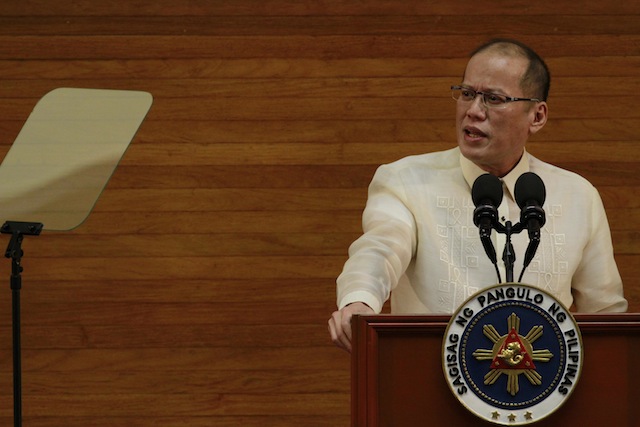 President Benigno S. Aquino III delivers his 6th and final State of the Nation Address during the joint session of the 16th Congress at the House of Representatives in suburban Quezon City, Monday July 27, 2015. Photo by REY S. BANIQUET/NIB
President Benigno S. Aquino III delivers his 6th and final State of the Nation Address during the joint session of the 16th Congress at the House of Representatives in suburban Quezon City, Monday July 27, 2015. Photo by REY S. BANIQUET/NIB
“I saw a leader who genuinely desired good for his people in the most conflict-ridden part of the country. He was the leader who sincerely recognized the justness of the cause of our armed struggle and the rightness of real and effective autonomy for our people. He was the President who stood by and weathered the storm with the peace process and the BBL, at the expense of his political capital. He was the one who went on an arm and a limb to ‘beg’ the legislators to do right by the Bangsamoro and pass the BBL. He would not succeed. But that is not on him.”
“There is so much that this President has done for the Bangsamoro in his six years of service to the Filipinos. And for that, his demise is a cause for immense sorrow,” Basman wrote. (Carolyn O. Arguillas / MindaNews)
